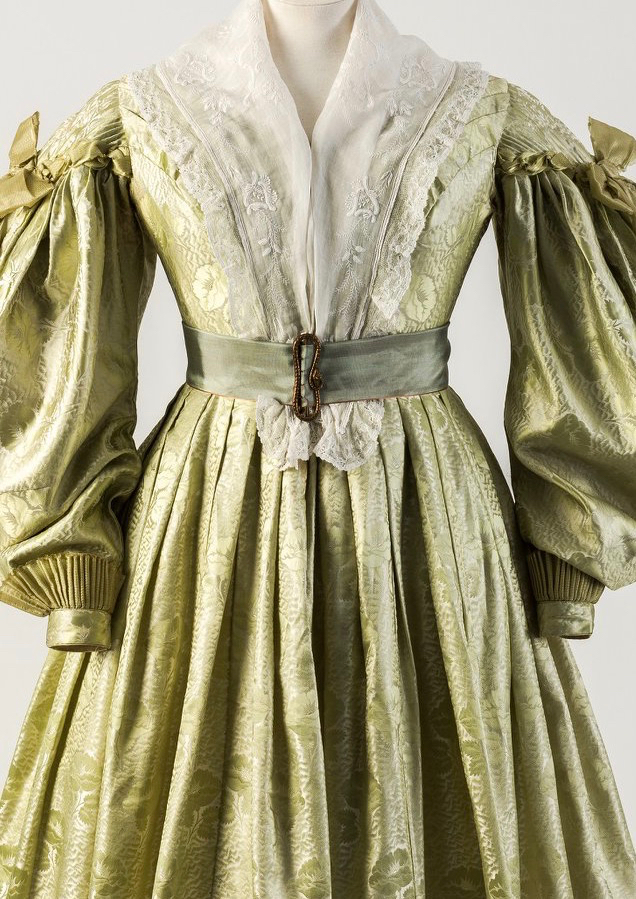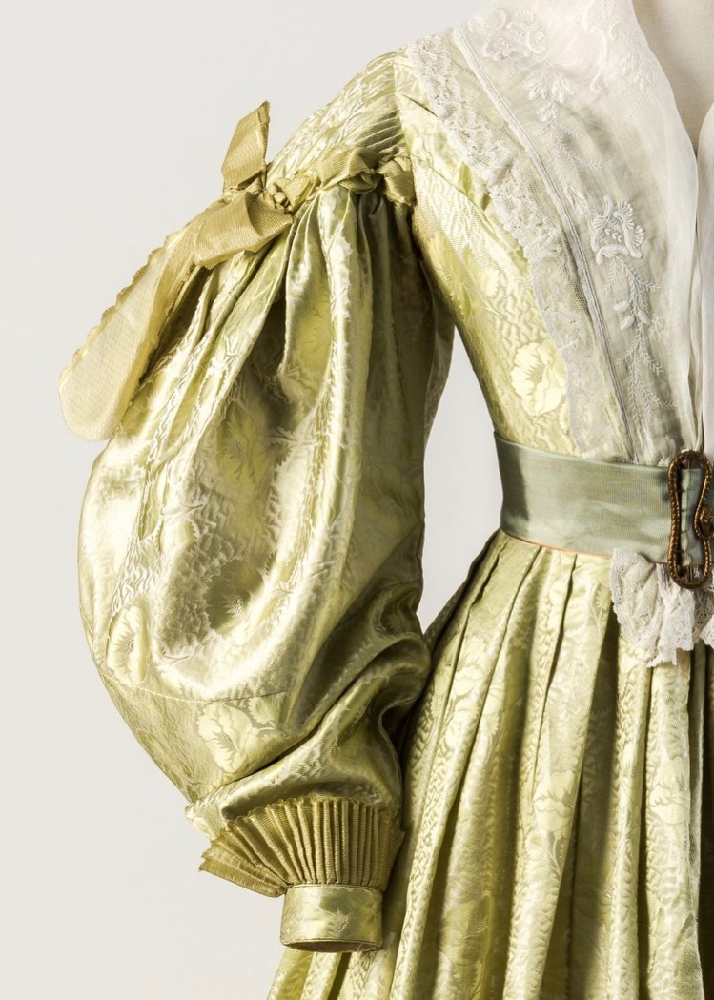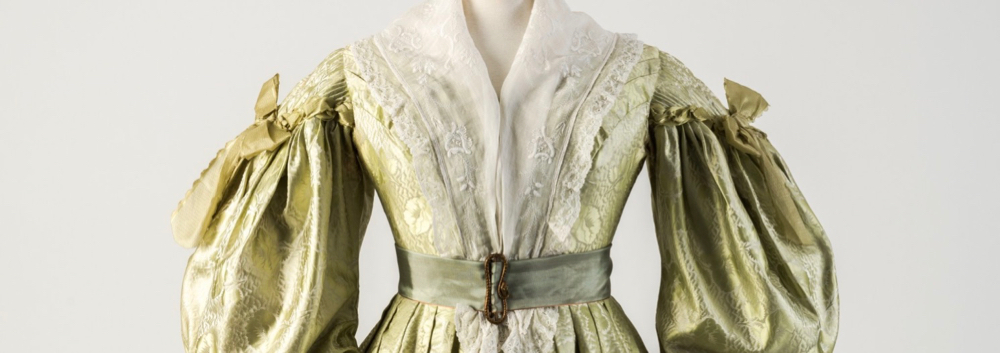This week we’re going from vibrant purple to restful green, and from a almost universally popular timeperiod, to one that’s a bit less of a guaranteed crowd pleaser. Can it score a hat-trick of 9.5+ ratings (without any hats involved)?
Last Week: a 1912 evening dress by Lucile
So many of you loved everything about this dress, and even those who didn’t rate it a perfect 10 only had the tiniest quibbles with its design: finding the colour not quite perfect, or the beads a bit clunky. Even so, it didn’t score a single rating under 8. A real crowd pleaser!
The Total: 9.6 out of 10
Just one point shy of the week before.
This week: an 1830s dress in morning glory patterned silk
Last week’s dress was an easy pick for popularity. Almost everyone loves the early 1910s!
The 1830s though? Up until quite recently they have been one of the least favourite decades for historical fashion. However, thanks to avid championing from rockstar costumers like American Duchess (and other talented costumers), the 1830s are seeing a definite rise in interest.
If you’re already an 1830s fan, will this week’s dress scratch your Romantic era itch? Or if you aren’t yet a convert, perhaps this will be the dress to bring you over to the bright-and-very-big-sleeved side? Or perhaps not…

This 1830s dress is made from pale green silk, with a jacquard woven damask pattern of morning glories.

It features the typical just-above-the-natural waistline of the 1830s, finished with a wide ribbon belt (possibly a styling addition by the museum, so you may choose not to put too much weight on it in your rating). It’s been paired with a delicately embroidered fichu: a common daytime accessory in fashion plates of the period.

The main area of design interest in the dress is that iconic feature of 1830s fashion: enormous gigot sleeves. These ones are gathered in to fit the armhole with narrow pleating, held in place with bands of ribbon arranged in poofs and secured with jaunty bows. Below the ribbon they fall in soft fullness, and are cut a little longer than the arm, so their extra length droops over the crisply pleated cuffs.

What do you think? Are you pro 1830s and think this one’s perfect? Or pr 1830s, but think you’ve seen much prettier examples? Or still not a huge fan, but can admire this as a lovely example of its type? Or just no-gigot no way?
Rate the Dress on a Scale of 1 to 10
A reminder about rating — feel free to be critical if you don’t like a thing, but make sure that your comments aren’t actually insulting to those who do like a garment. Phrase criticism as your opinion, rather than a flat fact. Our different tastes are what make Rate the Dress so interesting. It’s no fun when a comment implies that anyone who doesn’t agree with it, or who would wear a garment, is totally lacking in taste.
As usual, nothing more complicated than a .5. I also hugely appreciate it if you only do one rating, and set it on a line at the very end of your comment.


What a lovely fabric (and color), and one advantage to the giant sleeves and full skirt is that they give ample sweep to show it off. The fichu seems very well coordinated. The bullet pleats of the sleeves are impressive.
another 10 of 10
I am giving this one a 10 for a number of reasons
The lace and the embroidery on the fichu works so well with the pattern of the jacquard
the construction of the sleeves is elegant
The pleating into the shoulder seam and the addition of the pleated “peplum” at the cuff
I think the ribbon belt is a styling choice as I would assume that if there were an original ribbon belt, it would have matched the color (and the likely fading) of the sleeve ribbon
Additionally, it looks like it is a woven “border print” that was used effectively by the dressmaker
10/10
Resort wear for the 1830s. It’s a lovely, feminine look.
Pretty and inoffensive dress. Except for the sleeves. Sorry, but they ruin it for me. 5/10
I am a fan of statement sleeves , love the detail on them . A very pretty dress, the fichu works with it and l can imagine it worn with a belt or sash to emphasise the waist
A definate 9.5 only because l like more vivid colours
Such lovely fabric and I like everything except the sleeves I’m afraid.
So only 8/10
I think it’s gorgeous and love everything but the pleats on the cuffs.
9/10
I love the whole thing. That fabric is marvelous; not what I’d expect for an 1830’s dress. As for the sleeves, I think they’re just enough for the period– any more poufs and puffs would have been too much with the elaborate fabric.
I like it, though I think I’d like it more without the belt of a different green. For some reason having that sagey green next to the light golden green makes the whole gown look faded. Without it, I think it would appear simply delicately coloured.
I like the jacquard too, but I wish my mind hadn’t started interpreting the petals as lips – once seen, hard to unsee!
The fichu is gorgeous.
8/10
I’ve just been enjoying your archives. Thank you so much for a wonderfully enjoyable blog.
I
I am normally not drawn to 1830s or 1840s close but this is exquisite it’s it’s simplicity at its elegance and the details are just perfect the color is amazing it is so happy and springy it would look so nice with a little straw hat with some flowers to coordinate with the beautiful green dress I just can’t say enough about this this is a great dress I’m giving it a 10 out of 10
1830s is not my favourite, but I do find it very visually interesting. This dress is lovely–the fabric is absolutely gorgeous and I love the pleating at the cuffs and the tops of the sleeves.
10/10
I love it! But I do think the sleeves need frontlines; they aren’t poofy enough. The pleats at the cuffs are so sweet and the color is yummy. Yes, please! 10
Simply beautiful.
In my opinion, whoever chose the fichu and belt to pair with the dress was a genius, because the combination of fichu, belt, and gown is magical! The pattern of the lace on the fichu harmonizes with the morning glory pattern of the gown fabric, and the delicate vertical buckle fits in so well with the rest of the elements of the gown. (The belt could have been a better color, but the fact that it has faded makes it harmonize quite well with the gown’s color.)
The only objection I originally had was that the green of the gown was too yellow, too glaring. But having continued to consider it while composing this comment, I’ve changed my mind. I think it’s perfection (which surprises me because I’m not normally one to favor yellow-greens OR 1830’s silhouettes).
10 out of 10.
Just love this! 10/10
Rather like this – the fichu just sets it off perfectly. I’m actually rather fond of the sleeves, they just echo the era so perfectly! I wonder what variations on the big boofy 1830s sleeves are? We seem to focus a lot on the decades rather than variations within the period. The pale green not my favourite, but it’s just so nicely patterned. (That’s a heightened natural waist? Hmmmm, maybe that’s why my jeans never fit …)
10/10
I had always looked at the 1830s as a ridiculous mix between Regency simplicity and Victorian stiffness. This dress really makes me see the elegance and pleasing feminine shape of the era, and how fun the huge sleeves could be (probably also influenced by the recent statement sleeve trends).
My only problem is the green off the fabric. It makes me nauseated, or at least queasy, a weirdly strong reaction. However, the amazing sleeves (that pleasing! such volume!), belt and fascinating damask make me give it an 8.5/10.
ooooh, glorious! i’m rather fond of the romantic period in dress…it’s true, some of the creations are a bit over-the-top (but that’s kind of the point?), and no one can deny the sleeves are often mad, and the trimming can be positively fussy at times. but this frock avoids neatly the main perils of its period: no excess of bows like a flock of ribbon butterflies, large but not insanely ballooning sleeves. it’s made in a beautiful, exquisite fabric and i think the colour is delightful. and i adore the restrained and effective use of the tightly pleated bits on the sleeves. the fichu is very fetching, too. love the whole thing.
10/10 from me.
Love this dress/ensemble! It looks like spring just walked into the room. The bow and pleated cuff give the sleeves that little bit extra to set them off without going over the top. I would so make this dress if I could find the appropriate fabric!
10/10
I give this dress a 10. Love vintage wedding dresses
I’m definitely pro-1830s, and this dress is just gorgeous. Colour, pattern, design and shape are all lovely.
10/10
I don’t exactly love the shoulder bows, but overall the sleeves look a little flat (?) the volume is a lot lower than I’m used to seeing – it almost looks like a combination of the gigot and bishop sleeve? Other than my confusion over the sleeves, the fabric print is gorgeous, and I love how the fichu pairs with the dress.
8/10
The fichu coordinates with this spring green so beautifully. The whole look seems light and airy because of the colors and the delicate embroidery. I think of swishing skirts and garden strolls. I will never love poofy sleeves, but these are nice with the longer length. The cuff pleats give them an edgy fashion and tone down the fussy bows. And I like the belt, but it doesn’t count! I hope the dressmaker kept some of that silk for themself! Pretty one!
9/10
As far as 1830s fashion goes, I like it. 1830s has usually really crazy accessories and hair that I find ridiculous and none of it is present here :).
My only regret is the pleated ruffle at the cuffs reminds me of some truly unfortunate eastern block 1970s blouses… If it was pleated the same way as it is done on the shoulders, I would like it.
8.5/10
I’m not usually especially drawn to 1830s dresses, but this one I find compelling. The fabric is so incredibly rich looking, I’m dying to touch it. I actually find the dress+fichu+belt combination to be very pleasing, and the overall effect very harmonious. The sleeves are rather magnificent, of course, I particularly love the crisp pleating at top and bottom in the smooth and lustrous fabric, such a great set of textures!
A surprised 10/10 from me.
This is one of my least favorite eras for fashion.
But, the fabric is lovely, the design adds a few individual touches (the pleated cuff, the shoulder pleating that looks as if it’s held by the bows), and it’s a good representative of the era …
9.5
Love the fabric – the color and pattern. I like the shape of the bodice and skirt. I’m not such a big fan of gigantic sleeves, but these sleeves are not as overwhelming as some I’ve seen
9.5
I love the 1830’s (being very partial to big sleeves). With the restrained color, this is quite pretty and subdued (at least as subdued as a dress with 1830s sleeves can be). My personal taste in 1830s is usually for something a bit louder, but I think this dress would really shine once it was paired all of the accessories and the 1830’s hair.
9/10
The one thing I really don’t love about this dress is the pleated frills at the wrists – I think they’re unnecessary, strangely harsh, and don’t really go with the softness of the rest of the dress. The pleating at the shoulders is structurally logical and makes sense, but the cupcake frills at the wrist kind of annoy me. Otherwise, I love the softness of the green and the subtlety of the white patterning, and I like that the silk looks soft and draping too. Styling wise, I would prefer if the pelerine/cape extended well down over the skirt, OR if it were not belted in, but that’s the mounting decision and nothing to do with the dress, so I will say
8.5/10.
I’m normally not a fan of this era, but I love this dress!
The colour and shine of the silk are fabulous and I really like how well the positioning of the pattern on the bodice goes with the fichu.
The pleating at the wrists stops it from being too twee.
I choose to ignore the colour of the belt, I agree that it might not be originally belonging to this dress, a cream colour would complement the dress much better.
I like it much more than the purple one from last week.
10/10
I’m never too sure how I feel about 1830s dresses. On the one hand their dramatic and good fun, but then they’re also frilly, twee and rather absurd. I do really like the fabric of this dress, the colour and pattern are beautiful but I just can’t love the gigantic sleeves.
7/10
Not my period, but I LOVE this dress. Love the sleeves, especially the shoulder pleats, and love the green fabric. I understand Daniel M-C’s note about the cupcake cuffs but w/e.
Maybe it’s being COVID-stuck-at-home but..
10
Very beautiful fabric, although not my favourite colour.
Unfortunately I’ve never quite managed to get past those 1830s silhouettes. So poofy EVERYWHERE!
7/10
I love it!
The color and fabric are gorgeous. It’s very hot today where I am, and that might have an effect on me; that green looks so cool and refreshing.
The 1830s are not my favorite decade, in general, but they’ve slowly grown on me, and this dress is one I could see myself wearing. I love the little pleated cuffs, which somehow both remind me of a clown and charm me at once. They echo the gathering at the top of the sleeve and pull it together. The sleeves themselves, while huge, don’t look too overpowering; I think it’s the softer shape and the relative simplicity of the trim.
The bows are a little over-the-top, but they work with the general over-the-top-ness of 1830s fashion, and I love the placement: the choice to mark the line where the gathers stop with the ribbon trim makes me very happy.
I actually like both the belt and fichu; the fichu works with the light, airy look of the dress, and the belt provides a very nice contrast without spoiling the cool effect of all the green. I just wish I could see under the fichu, because it looks like there’s some interesting seaming around the neckline (one of the few parts of 1830s fashion I unambiguously love).
On looking more closely at the bodice, it seems that the bodice might be made with the wrong side of the fabric, as the flowers look lighter than the ground, instead of darker? Was the bodice turned, or is something else going on?
Anyway, I want it.
10/10.
I want it, I love it, So sophisticated and intriguing!â¤ï¸â¤ï¸
10… Beautiful! Love the time-period. Would love to have worn it.